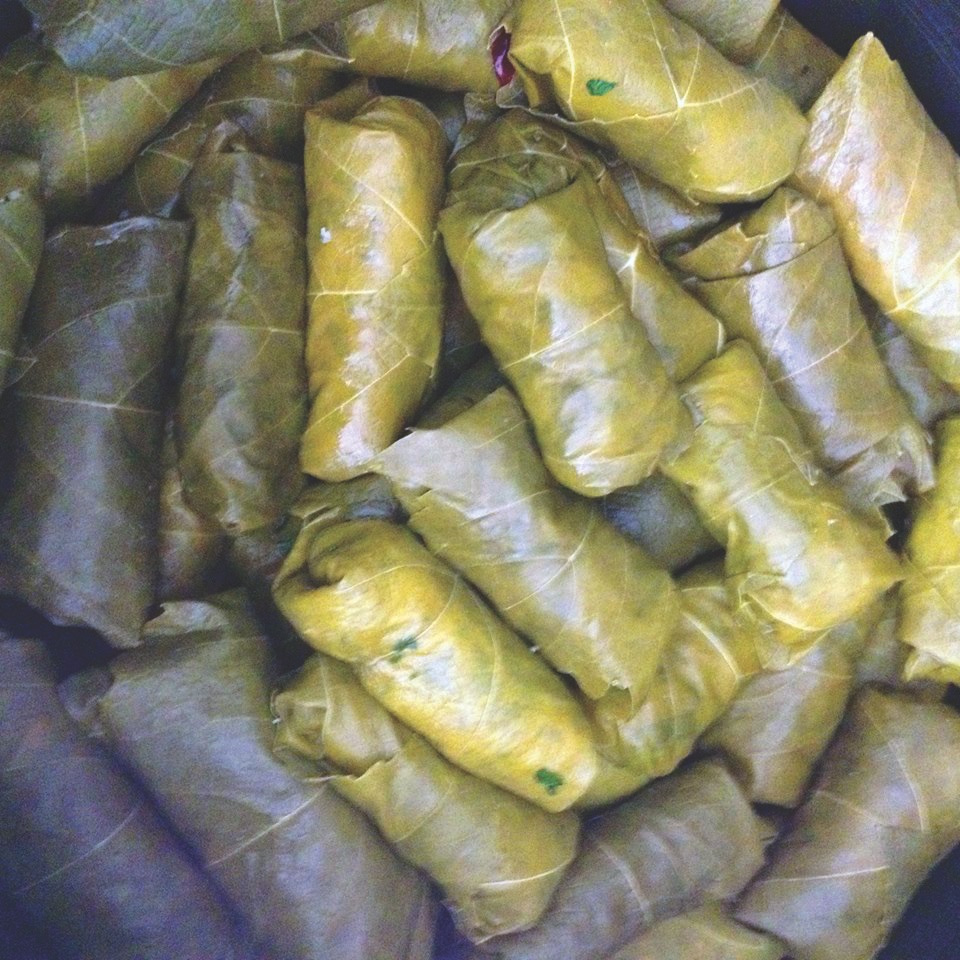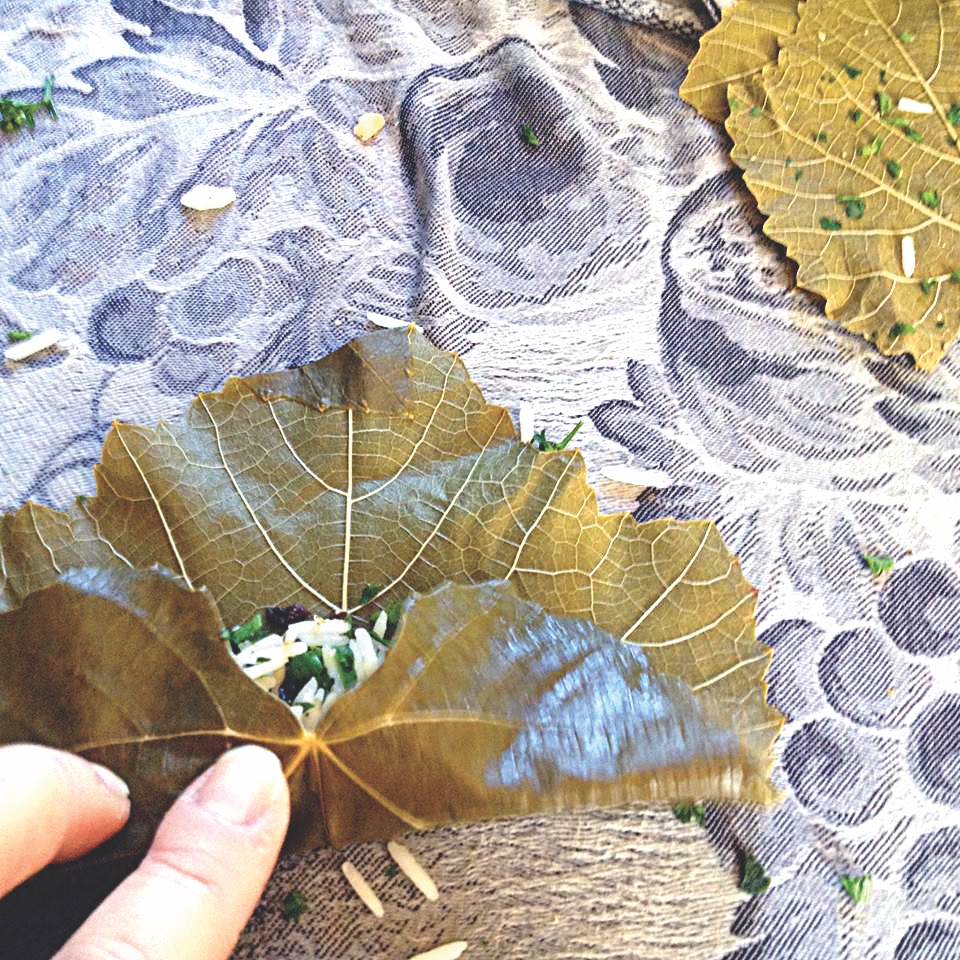
Dolma, dolmeh, tolma, yaprak, sarma, sarmi: It doesn’t matter what they’re called, the humble grape leaf has tremendous power. Depending on whom you ask, stuffed grape leaves have a variety of names and fillings; many cultures claim their invention. The Greeks believe they were served to the Gods on Mount Olympus. The Turks think they were introduced to the Middle East by the Ottomans in the 16th century. But in my father’s family, sarmi — meat-and-rice filled grape leaves — are the provenance of our Bulgarian kitchen.
I’ve been eating stuffed grape leaves for my entire life. In fact, my love of cooking can be directly traced to watching my aunts picking, stuffing and rolling them before I was out of my high chair. My mother carried on this tradition when we came to the United States, and any time my father needed cheering up, or at any family celebration, they made an appearance on our table, cooked in tomato sauce and smothered in cooling yogurt. They are a piece of home, a symbol of family and our Balkan roots. I don’t remember a time when I didn’t love them, hot or cold. It wasn’t until I moved to Africa, where they are not a common sight in grocery stores, that I didn’t cook them often.
Imagine my joy at receiving a box of freshly picked leaves delivered to my restaurant from an Armenian customer who remembered my lament about not being able to find them. I washed the leaves, blanched them in salted water for a few minutes, removed the long part of the stem that attached them to the vine and rested them in salty brine in a jar in the fridge.
As I was doing this, I remembered the entrance to my aunt’s apartment building in Tel Aviv that had a wild grape arbor near the garage. No one seemed to have planted those vines, but they supplied our family with stuffed grape leaves for what seemed like a thousand meals.
Stuffed grape leaves are not complicated to make, but they demand full attention and unwavering patience, two traits that I do not possess in abundance. Because I’m more the multi-tasking, high-energy type, rolling grape leaves is an exercise in my will to keep a quiet mind and steady hand. Preparing them is also an invitation to Memory Lane, my mother’s house, my father’s smile and almost all of our family gatherings in Israel.

Imagine the ingenuity of the person, no doubt a Sephardic Jew, who realized how delicious this humble, little leaf is.
Imagine the ingenuity of the person, no doubt a Sephardic Jew, who realized how delicious this humble, little leaf is. It’s hard enough to imagine how they decided that the fermented fruit of the plant could become wine but how they discovered the delicacy of its leaves stuffed with a filling and cooked boggles the mind.
It’s almost sacrilege in my family, but I’ve found that the grape leaves I love best are not cooked in tomato sauce or stuffed with meat. I prefer rice-and-pine nut stuffed vine leaves cooked in a garlicky elixir of lemon and olive oil. That’s the thing I love most about cooking — that even though our experiences and tastes may be shaped by our first glimpses of what our family and even our ancestors may have eaten, we are not limited by their tastes. We are still able, if we are willing, to take family traditions and spin them our way.
It may sound odd, but whenever I’ve been lucky enough to walk through a vineyard, even in some of the most beautiful places on earth, I don’t think about wine. I think about my mother and my aunts placing an inverted plate on top of stuffed grape leaves to hold them together during cooking. Maybe many years from now, when I’m gone and buried, someone I’ve made these for will walk around a corner and see a grapevine growing wild in the shadow of a tree and they will think of me, too. That’s how powerful a grape leaf is.
SARMI – STUFFED GRAPE LEAVES
1 16-ounce jar prepared and brined grape leaves
1 cup long grain rice
1 cup finely chopped parsley
1/2 cup finely sliced scallions, green and white parts
1/4 cup pine nuts, coarsely chopped (optional)
1 1 /2 teaspoons kosher salt
1 teaspoon black pepper
1/2 cup olive oil
1/4 cup freshly squeezed lemon juice
2 teaspoons sugar
3 cloves garlic, finely mashed to a paste
Thoroughly rinse the brine from grape leaves under running water. Place leaves in a bowl and cover with boiling water. Drain and rinse again and separate the leaves to remove the remaining brine and set aside.
Put rice in a pot of boiling water and stir well. Bring to a boil again and let boil for five minutes uncovered. Drain the rice in a strainer and rinse immediately with cold water. Drain again thoroughly to remove water.
To the rice, add parsley, scallions, pine nuts (if using), 1 teaspoon of salt and 1/2 teaspoon of pepper and stir to combine well.
Line the bottom of a 3- to 4-quart pot with some of the broken or large vine leaves ( there are always some larger or thicker leaves than the rest).
To roll them, place a leaf in front of you on a cutting board with the shiny side of the leaf facing down and the stem closest to you. Put a heaping spoonful of the rice mixture (more for the larger leaves) in a mound about a half-inch from the stem. Fold the stem end over the stuffing, and hold it down with your index finger. Then fold the left and the right sides of the leaf in like an envelope over the filling. Roll the leaf tightly away from you until you have reached the end of the leaf and made a small roll.
Continue to roll all the leaves until you run out of stuffing, laying them in concentric circles around the bottom of the pot. When the first layer is complete, continue to the next layer.
In a medium-sized bowl, combine olive oil, lemon juice, sugar, remaining salt and pepper, garlic and 1 cup of water, and whisk together until sugar dissolves. Pour mixture over stuffed grape leaves.
Lay an inverted dinner plate over the top of the rolls to hold them together during cooking and place the pot on medium heat. Bring to a boil, cover with a tight-fitting lid and reduce heat to low.
Simmer on low heat for one hour. Every 15 minutes or so, carefully lift the plate and baste the upper rolls with the cooking liquid. If all the liquid evaporates, add a bit more water. At the end of an hour, there should be a tiny bit of oil left at the bottom of the pot and no other liquid.
You can serve the leaves warm, but I like them cold out of the refrigerator the next day.
Makes about 50 rolls.
Yamit Behar Wood, an Israeli-American food and travel writer, is the executive chef at the U.S. Embassy in Kampala, Uganda, and founder of the New York Kitchen Catering Co.






















 More news and opinions than at a Shabbat dinner, right in your inbox.
More news and opinions than at a Shabbat dinner, right in your inbox.